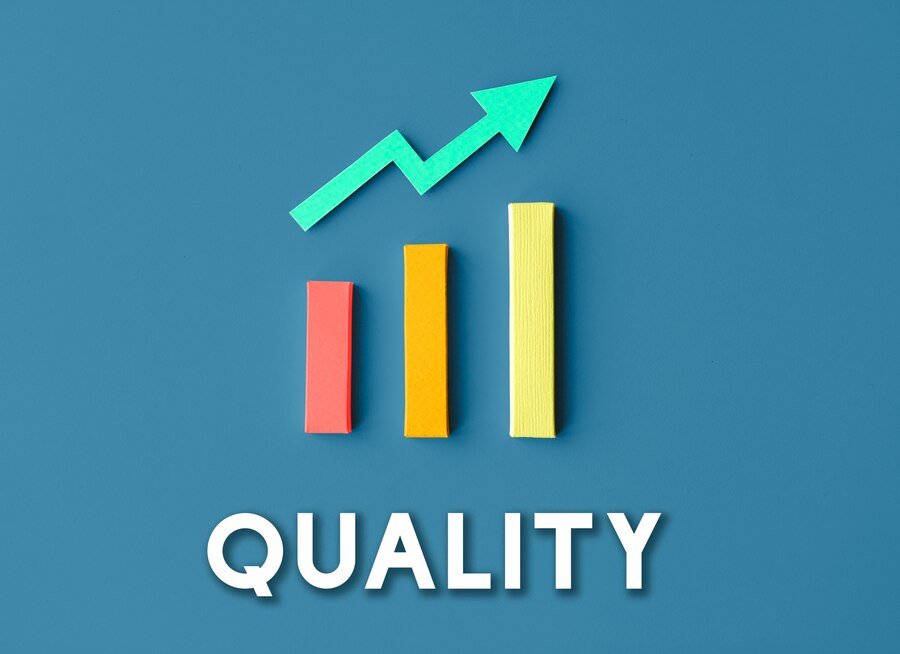
9.1 Introduction

In this module, we will consider the concept of quality - including its
definition, its characteristics and different ways in which to incorporate quality throughout
all operational processes of your organisation.
The first step is to try to define quality in this context. Actually, it is a very broad term which can
mean different things across different industries and even within different businesses. Not only is
quality difficult to define, it can also be difficult to measure in a clear and unambiguous way, as it
can be quite subjective in its characteristics - that is, it can mean different things to all of us.
For the purposes of this module and the relationship between quality and operations management, we will discuss the concept of quality across two key areas - as part of the design process and the
production process.
9.2 Ensuring quality in the design phase

There is a long list of factors within the design phase, which could
be assessed as good quality or poor quality.
We look at some factors below, but your own products or services are likely to have plenty of
others:-
The functionality/performance of the product
Before anything else, the design must meet the customer's needs (we have already discussed ways in
which to ascertain customer opinion and feedback, earlier in this course). The designer may believe
that his or her designs represent real quality from their perspective, but the customer won't agree if
it does not provide the functionality or contain the elements that are important to them. Secondly, the product must be fit for the purpose for which it is intended.
Qualities such as visual attractiveness can also be important as part of quality assessments, but will
generally not be acceptable in place of suitable functionality, unless the product has been designed
purely to be aesthetically pleasing.
The raw materials used to create the product
Quality in this sense is probably best defined as using the materials most suited to the product, taking into account its likely final use, location, design, etc. Quality of materials does not necessarily
mean using the best and most expensive on the marketplace, it means using the best and most fit for
the purpose of the characteristics of the final product.
Aesthetic features
Many customers deem a product of high quality to also need a high level of visual attractiveness. This may mean that its features have been well designed and are pleasing to the eye. Again, it can
be very difficult to achieve uniform consensus on the point of attractiveness and views can differ
widely. The views and expectations of the target customer must be paramount, in this regard.
Cost
Does the product represent value for money?
Value for money does not necessarily mean that it is cheap. It means that the customer is satisfied to pay the price in return for the quality and standard of
product or service that they are receiving in return.
Safety, security and conformance to regulations
Many products, particularly those that are to be consumed by humans or animals, or that could
cause potential damage if used under the incorrect circumstances, are subject to legal testing
processes, in order to ensure their safety in the marketplace.
How creative or innovative the design of the product is.
Depending on your industry, products which push the boundaries of current standards and designs
by innovative designers may be more likely to be described as being high quality.
9.3 Quality in the production phase

Many areas in which quality can be achieved have been covered in
the design phase and, as long as the quality standards agreed are adhered to and followed
through to the production stages, quality standards should be maintained on paper.
However, one of the biggest variables during production can be the standard of workmanship. This
relates to the standard of work that the tradespeople carry out during the actual process of
manufacturing the product. Quality can be built into the original design briefs, but if it is not
properly carried through to the production stage, problems with quality will quickly become
apparent and can be difficult and costly to rectify.
An important question for an Operations Manager to ask themselves is how can they ensure that
quality of design is successfully transferred to quality of production.
Training is a vital component and we discussed the value of implementing robust training
procedures for all workers, elsewhere in this course. Keeping employees and contractors fully
involved and engaged in the wider business is a good method to ensure their emotional investment
in the process. On this note, it might therefore be worthwhile to involve them in the quality focus at
the design stage.
Also, regular feedback, site supervision, formal inspections and continuous assessment of quality
during the production stage will help to retain a strong focus on quality for the whole team. Consider
using some of the methodologies that we have explored in the last couple of modules, such as
Kaizen/continuous improvement or Six Sigma, in order to ensure a focus on quality.
Quality assurance and quality control
As an Operations Manager, you are likely to hear these two terms regularly. They have similar
characteristics but mean different things and are sometimes incorrectly used interchangeably.
Firstly, quality assurance provides a set of tasks or processes for ensuring that quality is present
through the design and construction processes. It can include checks, samples, inspections, feedback and monitoring.
In contrast, quality control is more reactive in nature, as it aims to verify the quality of the finished
product and identify any issues or defects within its make up. A large part of quality control is the
routine testing of products to determine if they are within the correct and agreed specifications for
the final product.
Quality testing is likely to bring defects with products to light - either one off issues, or even a
design or production flaw which is impacting a whole group of products.
Identifying these faults quickly during the testing phase enables the team to put remedial actions in
place to rectify the flaws, before any further damage is done and before the issues reach the final
consumer.Testing at various points during the design and production process helps to identify
where a problem is occurring.
There is no single type of quality control that works across all products, as much will depend upon
the nature of the goods that you are producing.
By the way of example
In drug or food production, the testing process will generally focus on ensuring that the products are
fully safe for consumption by people and, therefore, chemical and microbiological testing of samples
from the production line are key.
Conversely, in an industry such as automobile manufacturing, quality control will be more aligned to
the way that the various parts fit and work together, making sure that engines and moving parts
operate smoothly and efficiently.
The role of quality control inspectors is to compare the product blueprints and specifications to a
sample of products at various stages of the production process. They will monitor the operations
process as a whole, to ensure that it meets safety and quality standards, not necessarily just relying
on the quality of the finished product, but delving deeper into the source of materials, design of
products, training of staff, etc, in order to ensure that quality runs through the process. As part of
their role, they will make recommendations to the assembly process.
9.4 ISO 9000

ISO 9000 is a framework of standards which give details about an
international standard of quality.
The objective of the standards is to define and provide a universal structure for an effective quality
assurance system, and is particularly useful for operations and production processes.
ISO itself is a non-governmental, independent and impartial organisation which operates
internationally, seeking to provide a consistent standard of uniform quality and therefore, consumer
confidence in products that hold the standard.
Seeking and working with suppliers who hold the ISO certification is a good way to ensure that the
quality of your products and materials is sufficient. Your business may also choose to take part in the
ISO standard, in order to offer your customers the same level of confidence in your own goods.
Standards in the ISO 9000 family (Iso.org) include:
* ISO 9001:2015 - sets out the requirements of a quality management system
* ISO 9000:2015 - covers the basic concepts and language
* ISO 9004:2009 - focuses on how to make a quality management system more efficient and
effective
* ISO 19011:2011 - sets out guidance on internal and external audits of quality management
systems
ISO sets out seven key principles relating to quality management.
Below is a brief description of each area:
* Customer Focus. In order to provide quality via service excellence, a business should put
customers at the forefront of all that they do.
* A successful business needs a vision and a set of values that underpins the activities that it
carries out and clear and strong leadership can achieve this, as part of the overall business
strategy
* Engagement of people.This relates to valuing and utilising the skills and knowledge of people, at all levels of a business
* Process approach.This links the achievement of an objective to the putting in place of a clear, structured and measurable process, in order to attain it.
*Continuous monitoring, innovation and improvement should happen on an ongoing basis, in
order to achieve good results
* Evidence based decision making.This defines robust decision as being the outcome of careful
and impartial analysis of information
* Relationship management. The network of individuals and organisations that are reliant on
each other, such as customers, suppliers, contractors, etc should work together for mutually
beneficial results
Advantages and disadvantages of ISO 9000
Although the ISO 9000 certifications are an international standard, some organisations have mixed
views regarding their effectiveness. On the plus side, many feel that the ISO 9000 standards provide
a clear, universal and unambiguous framework for the promotion of quality and the implementation
of quality management within a given organisation, or even within a discrete project. This can have
potential knock on effects to profits, waste, productivity and reputation in the marketplace.
However, critics of the model feel that the burden of money, paperwork and time to obtain the
standard could be counterproductive, as it has the potential to remove time and resources away
from the tangible result of quality itself, possibly leading to a “tick box” exercise in order to gain the
ISO registration, instead of a genuine and ongoing focus on quality. These potential benefits and drawbacks aside, as an Operations Manager it is important that you
understand what ISO 9000 is, what its main principles are and you can then decide, along with your
colleagues, to what extent you wish to invest in it, or use it as part of your purchasing decisions.
9.5 Quality defects

Some level of defects are generally unavoidable in the production or
manufacturing process, although an overarching aim of your business should be to reduce
the number of defects that you produce, thus improving overall quality.
However, before we can put measures in place to minimise the number of defects, we must
understand their nature and how to classify them properly, so that they may be analysed.
Types of quality defects
Defects are classified into three main categories - minor, major and critical.
Often, businesses will set targets or key performance indicators (KPIs) for the number of defects
which fall under each category.
Minor defects
Minor defects are small, typically insignificant issues that do not affect function or form of the item. If evident, such defects likely would not cause the customer to return the product because it is
unsuitable. Your orders can fail inspection, however, if the number of minor defects found exceeds
the limit set by the acceptable quality level.
Major defects
Major defectsare considered those which could adversely affect the performance of the product. Such adefect would likely cause a customer to return the product, as it is not fit for purpose.
Critical defects
Critical defects are those which would render the item unusable, or could cause harm to the user or
someone in the vicinity of the product. An item will often fail product inspection, if a single critical
defect is found within the order. Let's now get a little more specific and take a look at some types of common defects in different
product areas - minor, major and critical.
Soft product defects
These products can include fabrics, clothing and textiles.
Minor: Loose threads- these are particularly common in garment manufacturing, especially given
the amount of manual labourinvolved. Generally, they are either quickly corrected or left alone, as
they don't cause any impact to the finished product.
Major: Unsewn sections- missing stitches are usually relatively easy for a factory to rework and
usually need correcting, as they can cause functional or visible problems with the product.
Critical: A needle left in an item- this can happen if it is not picked up in quality inspections, either by eye or via a metal detector on the production line. If a needle or similar item is not found during this process and ends up in the finished goods, it could
be dangerous to the eventual wearer of the product and therefore, it needs to be corrected
immediately.
Hard product defects
These items could include products such as garden furniture or tools.
Minor: Small mark on the product's surface- an abrasion could result from a fault on the
production line, or even wear and tear during or after the production process. Minor damage to the
surface of a product can sometimes be tricky and costly to correct, but generally does not make the
product unsellable.
Major: Deep scratch on the product's surface- this may include abrasions that are very
noticeable and negatively impact the aesthetics or functionality of the product. Like light marks, these can be difficult to repair, but are generally not tolerated in a large number of units per order
and the customer is likely to be dissatisfied if they have purchased a product with these
characteristics.
Critical: Sharp edges on a product - similarly to soft products, if sharp points could cause
potential discomfort or harm to the customer, this is often cause for a failing inspection. Such issues
can sometimes lead to the products being recalled, part of the reason why they are taken so
seriously in the manufacturing industry.
Consumer electronics
Consumer electronics include products like mobile phones, cameras or computers.
Minor: Removable mark on item- product inspection can reveal marks on an item'ssurface, such
as excess glue. These are often considered minor - if they can be easily wiped away or otherwise removed.
Major: Product malfunction- if an electronic product fails to switchon or off, or shows other
malfunctions, this often considereda major quality defect. Rework of software or hardware may be
needed to correct the issue, in order to render the product fully usable.
Critical: Failure of an electrical or other safety test- if an electronic item fails a safety test, there could be risk of fire or other dangerous complications resulting from normal use of the item
and a serious risk to customers.
Industrial components
Industrial components is a broad term and could include materials such as fabricated steel.
Minor: Small imperfection or marks on the surface- these abrasions usually don't affect the use
or functionality of an industrial product, however you should analyse both the type of imperfection
and the intended use of the product, before deciding if this kind of quality defect is minor or has a
greater impact.
Major: Failed dimensions- a deviation from stated product dimensions might be considered a
major defect, even if these dimensions are not critical to the function of the industrial product, as
they deviate from the agreed standard and consistency of the product.
Critical: Rust or other degradation- depending on the applications of the product, this can be
considered a criticaldefect, as it can show early signs of the product's decline and the fact that it
may have a shorter than intended useful life.
Fact
There were about 256,700 toy-related injuries treated by
emergency personnel in 2013, many resulting in product recalls.
Source: The U.S Consumer Product Safety Commission.
9.6 Consumer product testing (or product optimisation)

We have already discussed the importance of quality control and the
testing that should routinely take place during the production process.
In addition to quality control, many companies also make use of consumer product testing, whereby
representatives from your target market trial and test the products to ensure real-life functionality
and approval.
Consumer testing in a real environment (essentially, testing a product the way in which it will be
typically used) is usually the most accurate way of evaluating the product.
For example
Asking customers to test food products in their own homes instead of in a test kitchen generally
produces more realistic results.
If you are considering implementing consumer product testing, a key consideration is how to ensure
uniformity of testing environments and consistency of results. In-house testing on a production line
is much easier to track and the environment is easier to control and real-life testing, although
generally preferable, can sometimes fall down if there is too much variation between the testing
situations.
To counteract this, you may wish to consider the following factors:
* Ensuring that products are identically produced, prepared and packaged, of a similar age and
from the same production plant
*You use the same method of data collection, such as identical questionnaires and feedback
mechanisms
*You use appropriate samples, to ensure clear results. This may mean assigning more weight to
the views of current non-users of your product if your market share is particularly low, in a bid
to increase this.
* Focusing on critical variables.This means that prime importance should be given to the views
of consumers over the views of the designers, safety and key functionality issues apart. The
critical variables, or the key product features that really matter to your customers, should be
defined in the early stages of the product's life through market research and then tested
thoroughly at this stage, to make sure that they have been met.
Activity 1
Estimated time: 15 minutes
Consider the business that you work for, or one with which you are familiar. Answer the following
questions:
What quality control processes are already in place? Can you think of any suggestions to
improve the current processes?
What consumer product testing processes are in place? Do they work well, or are there any
opportunities to make improvements?
9.7 Sources of potential conflict in operations management
![]()
The operations process, as many others, can sometimes create
situations that can cause conflict or disagreements between the individuals involved in the
process. Here are some common causes of disputes that you may find yourself part of, or with the
responsibility of dealing with.
For example
Mediating between two or more disagreeing parties
Defects
If your production process is suffering from a high rate of defective products, for whatever reason, it
can sometimes lead to a conflict. As customers are generally critical of defects and unwilling to pay
for corrective remedial action, or are unhappy about the inconvenience or adjustments to schedules
to resolve the issues, it can cause pressure within the business and some individuals can feel
blamed.
For example
Tradespeople or production operatives can sometimes feel that poor feedback calls the standard of
their work into question.
Power struggles
Due to the varied and multi-disciplinary nature of the field of operations with its many different
specialisms and trades, individuals can easily have differences of opinion, which, if handled poorly, can lead to conflict situations. Lack of adequate communication. This is a very common cause of conflict in the workplace, which certainly isn't unique to the
operations process. Poor communication usually results in misunderstandings, lack of clarity, or
even animosity amongst the team.
Fact
38% of UK employees report some form of interpersonal conflict at work in the last year.
Source: The Chartered Institute of Personnel and Development Survey, April 2015.
9.8 Mediation and arbitration
Ideally, issues should be raised and disagreements aired as early as
possible, in order to resolve them with the least amount of difficulty. Informal resolution should generally be the first port of call, where possible. However, if this is not
possible, there are more formal methods of resolution available to you.
For example
Mediation is a method in which to assist the parties in conflict to reach a mutually satisfactory
outcome. It is a voluntary process, which is not binding and relies on the collaboration and
cooperation of the parties involved, with a mediator to provide structure and impartiality for both
sides. If this is not possible or not successful, another possibility is arbitration.
Arbitration is a way of
resolving a conflict in a more structured and contractual way, usually by an external, professional
arbitrator from a third party and avoiding the use of the courts. The key principle of arbitration and the main way in which it differs from mediation is that the
result, as deemed by the arbitrator or arbitration panel, is binding. Both parties agree at the outset
of the process to be legally bound by the outcome.
Advantages of arbitration
It can prevent costly and lengthy court proceedings
It can generally be performed more quickly than court proceedings
If both parties agree upfront, they are bound by the outcome
Disadvantages of arbitration
It is more expensive than resolving the matter informally between the individuals. Both parties
must share the cost of the arbitrator and any other associated costs
There are few formal sanctions if any individual does not comply with the process of the
arbitrator's instructions, which can cause potential delays and added animosity
Activity 2
Estimated time: 10 minutes
As Operations Manager of a large manufacturing company, you have been asked to mediate in a
dispute between two production operatives who have differing views about the quality standard of
the products. Without knowing the exact details of the disagreement, summarise your broad strategy for helping
them to resolve the issue.